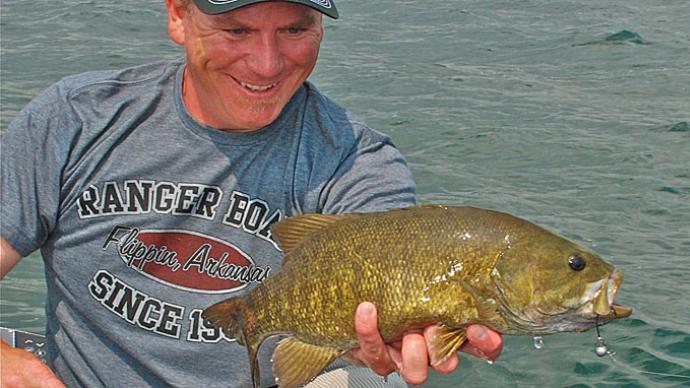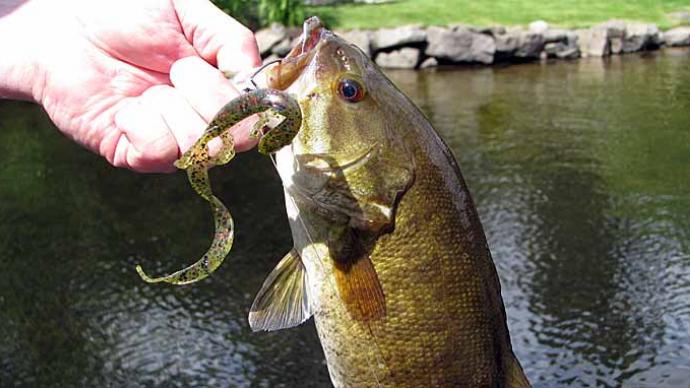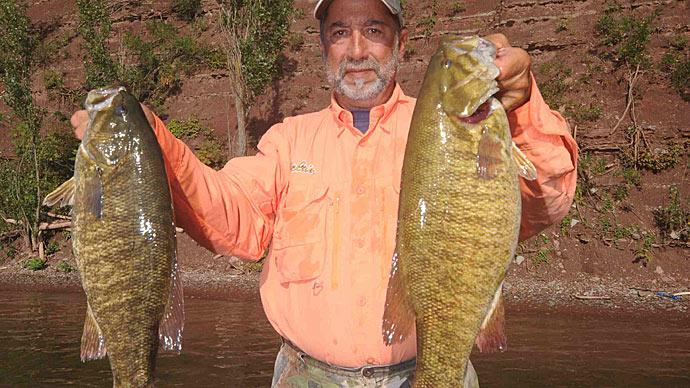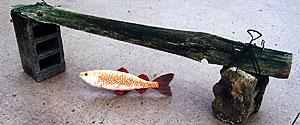
The homemade red and yellow popping bug plops near a pink water lily next to a big rock. I've seen a nice smallie hanging there... waiting for an easy meal. The ripples smooth to calm and just as I am ready to work the bait, that bass nailed the brightly colored lure. Hook set, the fight is on. He jumped nearly a foot out of the water! Then, again! Two great jumps from this feisty fish. My homemade bait worked and the knot held as I eased this dandy fish to shore. These fish take my breath. Great fun! Gotta love them smallies.
Over the last year, we have taken you through the basics of smallmouth production. We debunked the temperature myth, built habitat, learned how the creatures reproduce, what they eat, how they behave, what eats them, who competes with whom ... a fundamental trek through the lifestyles of smallmouth bass. Now, let's grow some fish. Traditionally, biologists will tell you it can't be done in warm water ponds. That trend is changing, dear pondmeisters. Next, I will tell you how to get fingerling smallies growing to bulldog fightin' acrobatic size in several short years.
Age and Habitat
Smallmouth bass life spans about 15 years to rare instances of 18 year olds in northern waters. Expect shorter life spans ... 7 to 9 years in more southern waters where faster growth and longer growing seasons occur. A fish has just so many heartbeats and in southern waters, those heartbeats take place much more quickly due to warmer waters and longer warm seasons.
Rule 1: No largemouth bass in your smallmouth pond.
When largemouths are absent, juvenile and adult smallies roam and rule the pond. Expect to find them most anywhere in the water. All sorts of submerged artificial cover are utilized by unthreatened smallies. However, when bigmouth bass are present they dominate the best feeding and spawning locations. Then, smallies are bullied and relegated to places of secondary importance that have less food and less safety of cover.
Many thriving smallie ponds near me in northwestern Ohio have low to moderate weed cover. This environment allows smallies to efficiently hunt and feed, yet provides just enough cover for forage and a few young bass to survive each year. Small to moderate percentages of weeds covering 10 to 30% of shallow areas, encourage production of forage foods while providing just enough refuge for maintaining breeder-sized forage fish.

Beneficial plants, for me, have been domestic water lilies. They are not rampant, are fairly easily managed and provide good habitat and cover for all sizes of fish. Good submerged plants are long-leaf pondweed and eel grass (tape grass). Good emergent plants are pickerelweed, arrowhead, water arum, sweet flag, rushes, reeds and spikerush.
Underwater weeds provide habitat to produce invertebrates, key components of smallmouth bass food chains. Insect larvae and aquatic worms thrive in this environment. A single long-leaf pondweed supported 555 invertebrates according to one count. Researchers estimated a 65x200 foot stand of long-leaf pondweed would support 33 million invertebrates in June and 30 million in August (Borman et.al.).
While a peripheral ring of the "right" kinds of aquatic plants around your pond is essential to produce foods for the smallmouth ecosystem, too many weeds can spoil the fun, making smallmouth work too hard trying to hunt and eat their forage. Small fish escape in thick, dense and abundant aquatic plants. The consequences are overabundant panfish ... if panfish are stocked with smallies. Nonetheless, the presence of moderate weed cover becomes much more important when just different species of minnows are used as forage.
Another key point here... Weeds as refuge for minnows as forage are more important in southern ponds where the period of heavy predation is longer compared to shorter growing seasons of more northern ponds.
Rule 2: Good types and amounts of plants are a key component to smallmouth bass success in small ponds.
Interactions
Warmwater fish reported as detrimental to smallies are: largemouth bass, green sunfish, bluegills, orange-spotted sunfish, redbreast sunfish, crappie, gizzard shad, and bullhead catfish. These fish are hardy and reproduce prolifically then compete for both prime habitat and food... making these fish part of the "problem" managing for smallmouth.
Consider combining smallies with non-reproducing species such as a few hybrid striped bass, walleye, an occasional pike or pickerel and maybe a few channel catfish. Remember, each other species of predator can easily eat 300-400 medium sized fish per year. Collectively, this amounts to thousands of small fish lost to non-target predators annually. Many of those fish can be young, slender bodied smallies, disrupting recruitment. Sometimes a few of these predators can help reduce young overabundant smallies.
Rule 3: Be thoughtful about the fish you wish to mix with smallmouth bass.
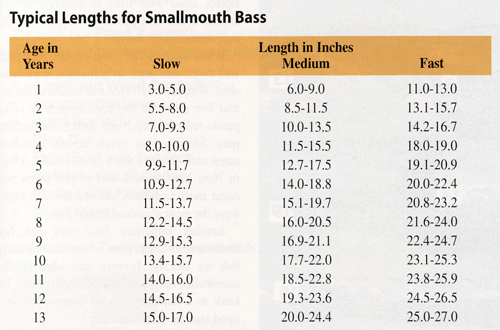
Growth Rates
Growth is influenced primarily by quantities of food, water temperature and competition with other predators. Factors resulting in best growth for young bass are: moderately warm temperatures, longer growing seasons, greater food availability, lower numbers of other smallies (or other predators) and less energy expenditure to capture food. Sound familiar?
Smallies in the four pound category (19") are considered exceptional prized fish. To reach the trophy category, smallies need ample food of the proper types and sizes during each day of their lives. In ideal conditions, a smallie can reach 6 pounds in six years. But in colder, far northern waters or cool, spring-fed habitats these fish may require 10 to 13 yrs to reach 4 - 5 pounds.
Smallie males and females grow at about the same rate throughout their life span. Sometimes, at a certain age or size class, growth will plateau due to inadequate food chains for that size of fish. When foods increase or the individual smallie finally grows to a larger size where it can eat bigger items not previously available, growth rates improve (Danehy and Ringler 1991). When a fish fails to grow rapidly at any stage of its life span, this fish won't reach its full potential or size because it lost significant growing time. It will never regain lost growth compared to same-aged fish that had abundant food daily.
Rule 4: Manage your habitat and food chain to produce the "right" size food for each size class of smallmouth you have.
Growth rates for smallies are generally better with soft-rayed forage fish and crayfish compared to spiney-rayed fish such as sunfishes and perch (Carlander 1977).
Here are some other important facts about growing smallmouth bass. Believe it or not, smallies and largemouth bass have similar water temperature preferences. Growth of smallies and largemouths decreases dramatically at 95F, although survival of both was good at this temperature (Coutant 1975). Typically, best growth for smallies is around 80-85F. This is contrary to what many of us have been taught over the years.
Another key point about bass is to avoid excessive turbidity. Turbidity, whether due to clay and silt or simply an overly dense or nuisance plankton bloom, reduces the pond's overall food factory and inhibits visual feeding of all types of basses.
Natural Foods
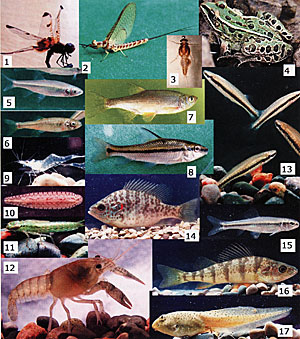
As smallies grow larger, into the 12-14 inch size class, they generally do better when consuming larger food items as opposed to insects, bugs, and small two inch fish. For smallies to have the best chance of putting on the feed bag and staying fat and sassy, this means keeping food items abundant and competition low from other types of predators. (See Rule 4).
Optimal foraging is important for producing big smallies. Optimal foraging is getting the most food using the least amount of energy. To get the optimum foraging theory working for you, your smallie pond should always have diversity and abundance of natural foods. Many food items are seasonal in a pond. Some good common foods for smallies are shown in Plate 1 (see pic).
Adult smallies have superior abilities to subsist on invertebrates and smaller foods, although a primary diet of bugs and little fish results in slower growth. A study of ponds in Illinois concluded twice as many smallies per acre, when compared to largemouth, could be raised naturally per acre (Buck & Thoits 1970).
These authors concluded intermediate-sized smallies were superior foragers and more efficient converters of smaller types of invertebrate foods than largemouth.
Normally, aquatic insects do not have to be stocked into ponds. Provided adequate habitat is present, adult aquatic insects have a very good ability of expanding into new water by flying from pond to pond, laying eggs and thriving. (See Rule 2)
Rule 5: Keep the foods diverse and abundant, based on the size classes of smallmouth bass you have.
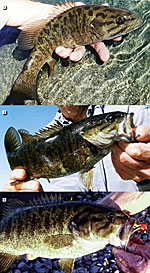
Smallies and crayfish go together like peanut butter and jelly. When common, crayfish compose up to 87% of the annual diet for adult smallies. Crayfish are normally dormant and scarce during late fall/winter. Studies have shown crayfish are not as high in nutrition as fish. However, smallies readily eat crayfish because they are adapted for locating and capturing the clawed creatures.
Crayfish are beneficial for ponds, too. They are noted for foraging on vegetation. When abundant, crayfish can reduce and even eliminate some submersed plant densities. Rock piles provide refuge areas and foster development of most types of crayfish. Attached algae growth on rock piles and submersed plants provide good crayfish food, too.
A key part of this puzzle is habitat. Crayfish thrive in habitat preferred by smallies. These areas include deposits of large tree limbs, riprap, areas with slabs of concrete or large broken rocks that provide numerous crevices and overhanging shelves.
When smallies catch and eat fish, they prefer soft rayed fish such as minnows, shiners and shad. When spiney-rayed fish are eaten, the ones that live closer to the bottom such as yellow perch, red ear sunfish and darters are preferred prey. Small yellow perch are not commonly eaten until smallies reach 10-12 inches. A study in New York State found yellow perch were eaten most frequently despite the fact sunfish were the most abundant forage fish.
Another important food fact has been discovered in small lakes where suitable forage fish are lacking. Juvenile and adult smallies cannibalize only 6 to 26% of smaller bass. This leads to a tendency toward overpopulation, if good spawns occur annually.
One goal should be having some adult brood stock forage fish and crayfish present late spring each year. These brooders produce necessary foods for upcoming growth. No adult forage fish brood stock present in spring? Then you likely have too many predators and not enough refuge areas and shallow water habitat in your pond. Solve that problem, first.
Smallie Management
If you want great smallies, don't let them overeat foods the pond is able to produce naturally. This means occasional sampling of your baitfish to look at size distribution and abundance. For a balanced fishery, you should always be able to see or commonly catch natural food items in the pond.
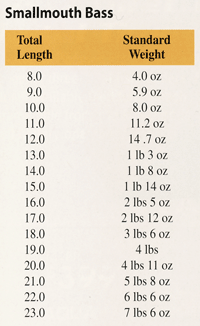
When are there too many smallies and which ones to remove?
Typically, I become concerned when I catch a thin bodied or noticeably skinny smallie. This fish should be removed regardless of its length. If you are commonly catching thin smallies, or mostly the same sizes of smaller ones, then you probably have too many and some cropping needs to be done.
Rule 6: Harvest will be inevitable, so keep good records of lengths and weights of fish you catch.
Determining what size smallie to remove depends on your goals. Do you want to catch lots of bass and are not real concerned with regularly catching really big ones? Then typically remove the bigger, older and wiser bass, those larger than 16-18". This will provide more food and space for smaller, younger, more aggressive bass.
Want bigger smallies? Use a slot limit to remove numerous smaller bass in the 7" to 10" size class. This adjusts the numbers to have greater numbers of larger bass. Remember, a pond can sustain bigger numbers of smaller, more aggressive bass than it can support numbers of larger shy-bite bass. Larger, harder-to-catch bass quickly add poundage to the total carrying capacity of predators in a pond.
A sure sign you have too many smallies shows when forage fish are not as noticeable or common as they once were. When predators are actively feeding, usually during morning or evening, smaller forage fish try to avoid the bass and commonly collect in shallowest areas. They are visible near shore and submersed structure. If you don't see small fish, then it is time to consider removing some predators and/or providing more dense shallow water cover.

Several studies have found smallies can maintain relatively high standing crops of bass per acre. Common carrying capacities of largemouth bass range from 50 to 130 pounds per acre, whereas for smallies it is 70-180 pounds per acre. This is due to the ability of smallies to forage and survive very well on invertebrates, where largemouth bass strictly make a living chasing top end prey.
Another small, 1.2 acre pond was studied for 13 years. It contained smallies, lake chubsuckers and minimally-reproducing hybrid crappie. Annual angler harvest of smallies in this pond averaged 73 pounds per acre (27 to 88 lbs/ac). The harvest fell below 50 pounds/acre in only four years. It was thought the smallies were easier to catch and more active compared to largemouth bass in other waters. Authors thought this combination was capable of maintaining itself indefinitely where an average of 75 smallmouth were caught per acre per year (Bennett & Childers 1972).
Catch and Release
Be aware that frequent catch and release angling in smaller ponds can result in creating large bass difficult to catch. Eric West explains this feature and provides ways to combat it in Pond Boss magazine, Sept/Oct 2009, pg 58 - Catchability and Heredity.
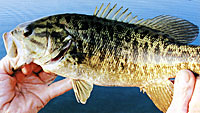
Researchers studied the stress-effects of catch and release angling on nesting smallies. Nest guarding smallies caught by hook and line were played either for less than 20 seconds or to near complete exhaustion. For smallies played to exhaustion, about 50% of their energy reserves were depleted, which caused high stress. Smallies quickly landed had five times less sore muscle chemical present and had measurably faster recovery times.
Removing males from nests disrupted parental activities and resulted in lack of protection, which left young fish or eggs vulnerable to nest-robbing predators. It took exhausted fish an average of 8 minutes to return to nest guarding...more than ample time for nest robbers to eat eggs or fry. I suggest you resist the temptation to catch smallies during spawning season.
Well there you have it, my complete pond owner's guide to growing smallmouth bass. From temperature and habitat preferences, requirements for spawning, building better spawning areas, producing good fingerlings, to growing and managing adults.
You really can grow smallies in a pond, even a pond many thought too warm for smallmouth bass.
Remember
- Smallies can survive well in warm water ponds and produce relatively high numbers annually if LMB are not present.
- Smallies grow best with a diverse forage base dominated by crayfish, minnows, and shiners. Use a diverse group of available forage fishes and invertebrates to keep the smallies growing well.
- Constant abundance of several types of foods helps prevent smallies from overexploiting one specific food source while allowing other forage types to reproduce and repopulate.
- For the biggest and best bass, keep numbers of forage fish high and numbers of smallies lower.
- Annually check size classes and remove skinny bass.
- Have lots of fun fishing.
I especially thank Charles Kurtz for allowing pond sampling and collection of smallies for these articles.
Reprinted with permission from Pond Boss Magazine

